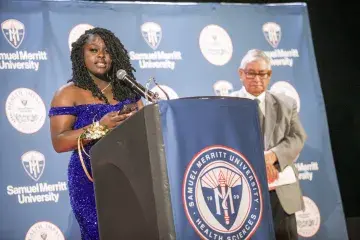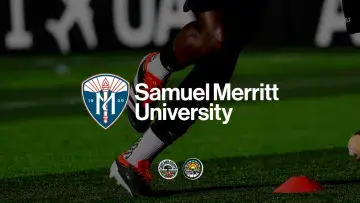SMU Podiatry Students Study Impact of Competitive Gymnastics on Feet of Young Athletes
Two Samuel Merritt University (SMU) podiatry students are investigating the prevalence of flat feet among young female gymnasts to determine if the high-impact sport weakens their feet’s soft tissue and puts them at risk for injury.
Ashmi Patel and Lena Sun, third-year students at SMU’s California School of Podiatric Medicine, chose to study gymnastics because it is one of the few sports that is performed without any type of footwear. They hope their independent research study will help healthcare professionals better treat various gymnastic-related injuries and enable gymnastic coaches to anticipate certain injury patterns in young athletes.
“What really drew me to this topic was the lack of gymnastics research and how the sport may affect the biomechanics of gymnasts,” said Patel.
The study aims to discover how the repetitive training exercises required of young gymnasts while barefoot, which can weaken and strain of important stabilizing structures of the foot, can lead to musculoskeletal changes such as flat feet that can cause ruptured ligaments and stress fractures.
“Not only is this a good research project in that it is contributing to a body of knowledge, but it gives them experience in collecting evidence that’s not classroom-based or part of clinical practice,” said Professor Drew Smith, PhD, director of the SMU’s Motion Analysis Research Center, which is helping the students with the study.
According to the students’ research proposal, competitive gymnasts are required to perform frequent, high-impact landings – sometimes performing more than 200 dismounts a week – and their feet are the first to absorb the pressure. Events such as vault, floor exercise, balance beam and uneven bars expose female gymnasts to abrupt loading rates of forces ranging from five to 17.5 times their bodyweight on their feet. Those impacts can destabilize the foot and also predispose gymnasts to ankle and knee injuries, leading to joint degeneration and soft tissue damage.
The students plan to examine up to 40 female gymnasts between the ages of 6 and 17 at Head Over Heels Athletic Arts in Emeryville, California, who have participated in at least six hours of gymnastics training every week for the past year and are not experiencing any serious orthopedic or neuromuscular disorders.
“These girls are high functioning athletes that may have underlying tendinous and ligamentous injury without really knowing it and they may also be asymptomatic,” Patel said. “If they do have those injuries, it would be very interesting to better understand how their musculoskeletal conditioning helps compensate for that.”
The study will gather the following information from each participant:
- Any current or previous injuries related to gymnastic activity.
- Evaluation and measurement of foot posture while standing in a relaxed position.
- Digital pictures of the lower leg to document measurements.
- Measure pressure under both feet while standing on an emed force pedography platform to determine where the participant applies the most pressure.
“If our study shows that these girls have a higher prevalence for flat feet, then this could provide a foundation to better understand flatfoot pathology in athletes,” said Patel.
Flat feet – also known as pes planus foot deformity – is surprisingly rare, according to the research proposal. Previous studies have demonstrated a 97 percent prevalence of flat feet in children 2 years or younger, but it drastically decreases with age with only 4 percent of children with collapsed foot arches by age 10.
Patel and Sun, who worked on their research proposal for the past year before gaining the approval of the University’s Institutional Review Board, hope their work will help spur future studies.
“It’s been a good learning experience,” said Sun. “I appreciate research papers more now because I realize how much work goes into it.”


